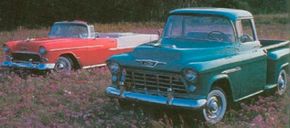1955 Chevrolet Truck Models
The 1955 Chevrolet truck models offered an impressive total of 75 "Task-Force" models on 15 different wheelbases designed for everything from light delivery to over-the-road hauling. Our focus here, though, will be on the light-duty lines rated up to one ton.
Pickups were spread liberally throughout the model roster. Series 3100 ½-tonners (including the Cameo) were on the standard 114-inch wheelbase. The lone member of the 3200 series was a ½-ton-rated long-bed pickup that shared its 123.25-inch wheelbase and heavier frame side rails with the pickup in the ¾-ton 3600 line.
Advertisement
The beefiest of all was the 3800-series pickup. Listed at one-ton capacity, it rode a 135-inch wheelbase. A new rear fender style graced all these trucks (other than the Cameo Carrier, of course). These larger fenders had a forward cant and were topped by a cap with a crease line that mimicked the bodyside sculpting on the cab. Base prices ranged from $1,519 for a fender-side 3100 to $1,844 for a 3800.
Variations abounded in the ranks of Chevrolet's light duty lines. The 3100 and 3800 series both featured a panel truck. Stake-bed and platform models were available in a choice of ¾- or one-ton ratings. Operators with specific needs could choose from chassis-and-cab, chassis-and-cowl, and chassis-and-windshield offerings in the 3100, 3600, and 3800 series that were intended to be fitted with aftermarket specialty bodies.
Exclusive to the 3100 series was the Suburban Carryall, a two-door station wagon based on the ½-ton panel body. Suburban buyers could choose between twin side-hinged panel doors or a two-piece tailgate. With the middle and rear seats in place, a Suburban could carry up to eight people. The bodyside crease that ran down the pickup cab spanned the full length of the new Suburban and panel truck bodies.
Chevrolet totally changed chassis frames when going from the First to the Second Series trucks. The former's frame was tapered: 26 inches wide at the front and 46 inches between the rails in the rear. The 1955 frame, on the other hand, had perfectly parallel siderails in plan view: 34 inches across at both ends.
Solid axles were retained fore and aft and used longitudinal leaf springs and tubular shocks at all four corners (although rear tube shocks were optional on 3800s). The I-beam front axle was widened and lowered for 1955.
Meanwhile, the front springs were lengthened in each light-duty series. The rear springs now attached to special outboard brackets, and the six-cylinder engine had a four-point mounting system instead of the previous three-point.
Buyers could take their choice of the traditional 235.5-cubic inch inline "Stovebolt" six or the new 265-cubic inch V-8. The V-8 was still so new that some people wanted to wait until Chevrolet worked out the bugs. And word soon got out that, yes, early Chevrolet V-8s did have one big bug: their rings were slow to seat, so the engines tended to burn oil. Mechanics soon learned to pour a little Bon Ami in water down the carburetor, which speeded break-in and ultimately solved the oil-consumption problem.
The Second Series six produced 123 horsepower at 3,800 rpm and 207 pound-feet of torque at 2,000 rpm. The optional Trade-master V-8, a detuned version of the hot new passenger-car engine, made 145 horsepower at 4,000 rpm; its peak 238 pound-feet of torque arrived at 2,000 revs. A one-barrel carburetor fed the six while a twin-throat unit served the V-8. Both engines had a 7.5:1 compression ratio.
Explore the available options for the 1955 Chevrolet light-duty truck line on the next page.
For more information on cars, see:
- Classic Cars
- Muscle Cars
- Sports Cars
- Consumer Guide New Car Search
- Consumer Guide Used Car Search
